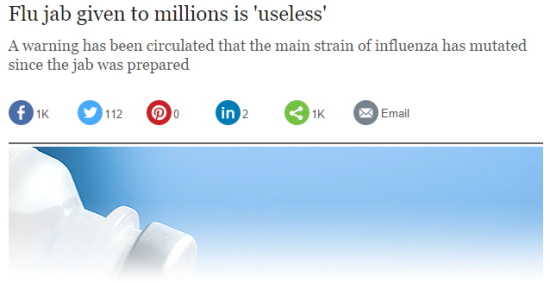Are flu vaccines effective? Prognosis: negative.
by Patrick – No comments. The post is really that bad, huh?
It’s that time of year again when government rolls out the “get your flu shot!” propaganda under the usual auspices of “keeping everyone safe”.
Well, you know…government.
Now I know that there are questions about the safety of flu vaccines, some of which (especially those indicated for very young children) contain thimerosal as a preservative, but that’s not what I’m talking about.


There are anecdotal indications in the news, and of course I have my own personal experiences with not contracting seasonal bugs while those around me (who proudly got the jab) got repeatedly sick, but these are hardly objective. So for this post I wanted to do a more thorough analysis using the statistics being provided by the very people making the claim that the flu shot keeps you safer: https://www.ontario.ca/page/flu-facts
On the same page that touts the flu shot as “the most effective way to protect yourself and your family from the flu”, the “Flu Facts” page links to Google’s flu tracker to provide yearly data on the infectious disease: http://www.google.org/flutrends/about/
The flu vaccine wasn’t widely promoted by the government until 2008 but has been promoted for kids since 2004. These dates, along with historical population numbers, provide a good basis to work with.
Here are the results of that work:
| Date | Total Recorded Canadian Influenza Infections | Population of Canada | Infection rate per population | Average per period |
| 2004-12-26 | 77828 | 32048000 | 0.2428% | |
| 2005-12-25 | 98859 | 32359000 | 0.3055% | |
| 2006-12-31 | 97598 | 32723000 | 0.2983% | |
| 2007-12-30 | 85821 | 33115000 | 0.2592% | |
| 2008-12-28 | 84826 | 33506000 | 0.2532% | 0.2718% |
| 2009-12-27 | 141118 | 33630000 | 0.4196% | |
| 2010-12-26 | 67855 | 34010000 | 0.1995% | |
| 2011-12-25 | 73778 | 34340000 | 0.2148% | |
| 2012-12-30 | 101581 | 34750000 | 0.2923% | |
| 2013-12-29 | 104231 | 35160000 | 0.2964% | 0.2845% |
| 2014-12-28 | 121388 | 35540400 | 0.3415% | 0.2940% |
I split up the values into two ranges (pre-2008 and post-2008) for which complete data sets were available. For example, although flu data is available for 2003, it’s only for a portion of that year so I excluded it. Similarly, since 2015 isn’t finished yet, I left it out. The above numbers are condensed from a larger data set which you can download as an Excel spreadsheet (.xls / .xlsx), or an Open Office / Libre Office spreadsheet (.ods), and you can always recreate the calculations from the sources I linked to above.
Of course it would be a wild leap to say that you are more likely to contract the flu because of the introduction of the flu vaccine (though this may actually be true), I think that this result demonstrates that the inverse claim is also dubious. In fact, it looks like the trend for influenza infections is actually climbing rather than receding.
What’s unfortunate is that many people, often the same ones that uphold objective science and reject theology, are willing to entirely and instantly reject any such claims when they’re contrary to those pushed forward by the “authorities”. Sounds like dogmatic religion to me, but what do I know, I must just be a bitter anti-vaxxer.




What's on your mind?